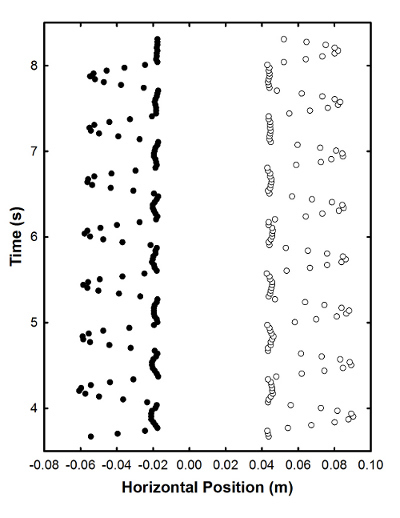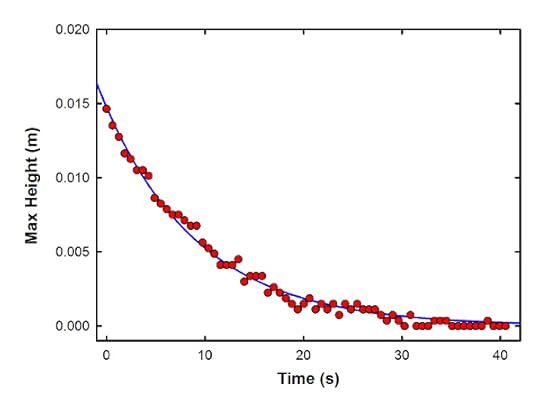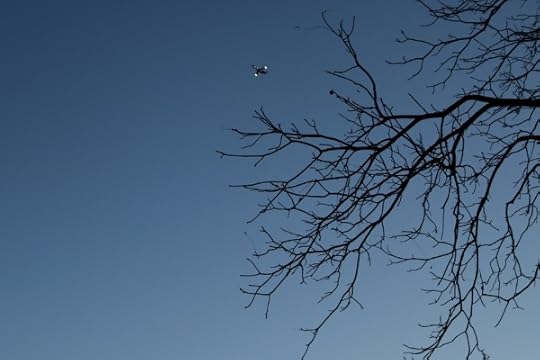Chad Orzel's Blog, page 20
November 7, 2015
067/366: Toast
I spent most of Friday in a bit of a fog, thanks to a cold bug I picked up from The Pip. As a result, the only thing I took photos of yesterday was this:

A piece of bread in the toaster at Chateau Steelypips.
This wasn’t some weird pseudoephedrine-fueled delusion– I actually had a professional need for a photo of bread in a toaster oven. But, um, yeah, that’s all I’ve got.
November 6, 2015
Speaking at TEDxAlbany, December 3
I’ve known this for a while now, but they just announced it officially: I’ll be speaking at TEDxAlbany this year, on “The Exotic Physics of an Ordinary Morning”:
You might think that the bizarre predictions of quantum mechanics and relativity– particles that are also waves, cats that are both alive and dead, clocks that run at different rates depending on how you’re moving– and only come into play in physics laboratories or near black holes. In fact, though, even the strangest features of modern physics are essential for everything around us. The mundane process of getting up and getting ready for work relies on surprisingly exotic physics; understanding how this plays out adds an element of wonder to even the most ordinary morning.
This is, obviously, related to a bunch of stuff I’ve written over at Forbes (and also a new book proposal…). It’s not a talk I’ve given before, either, which means I’m in the process of writing it and making slides and all that fun stuff. But I’m pretty psyched for the opportunity, and expect it will be fun.
It’s an all-day thing, and if you’re in the area and interested, they’re selling tickets. All the talks will eventually end up online, if past years are a guide, and it may be available streaming on the day of the event, too. So, you know, if you want to see me give a big talk, here’s a great chance…
066/366: Sky Full of Fire
I love a lot of things about our neighborhood, which is all pleasant tree-lined streets and stuff, but it’s not a great place for taking pictures of sunset– I pretty much need to get in the car to get to a place with a clear view of the western horizon. This knocks out a big category of imitation-Scalzi photos, but every now and then there’s a cool sunset-related effect, like these clouds last night:

Red patches of cloud at sunset.
This is kind of similar to the sunrise squirrel from a few days ago, but the lit-up clouds are a little more sparse, which makes it more dramatic.
And, of course, this kind of photo is a great illustration of optical physics, as the red color is caused by Rayleigh scattering. The shorter wavelengths that would ordinarily make those clouds white were scattered off to the side to make blue skies for people west of us. Assuming they had clear skies, anyway; they may well have just been staring at grey and dismal clouds.
This was delayed to morning by the rotten cold I got from The Pip. His birthday is this weekend, so I went to bed early to conserve my strength for the social event of the season on Sunday. For the pre-school set, anyway…
November 5, 2015
Union Jobs
Two positions of possible interest to academic job seekers:
— First, we’re hiring again in the Union college Department of Physics and Astronomy:
We invite applications for a tenure-track Assistant Professor position starting in September 2016, with a preference for an experimental physicist working in either biophysics or soft condensed matter. We encourage applications from interdisciplinary scientists and those who could make use of the College’s shared instrumentation resources (including AFM, SEM, micro- Raman and micro-FTIR instruments and IBM cluster computer; see http://www.union.edu/academic/learnin... for more). Applicants should have strong research credentials, evidence of teaching or mentoring a diverse student body, and a strong commitment to undergraduate education including research with undergraduate students.
— If that’s not prestigious enough, you could always apply to be my boss, as Union is looking for a new VP of Academic Affairs. It’s probably not all that likely that any great candidates for that position are reading this, but hey, you never know…
I’m on sabbatical and thus not directly participating in either search. I can, however, answer fairly general questions about either position if you shoot me an email.
Energy Dissipation in a Physics Toy
A little while back, I used a photo of SteelyKid’s toy Newton’s cradle as the photo of the day, with a bonus video:
I mentioned that I was going to do some analysis of this at some point, but didn’t have time right then. I had a bit of time to poke at this yesterday, though, so here’s some physics making use of the normal-speed part of that video (I have another purpose in mind for the high-speed stuff; you’ll need to wait for that).
The obvious thing to do with this is to plug it into Tracker and measure the position as a function of time. Here’s a graph tracking the position of the two end balls through several bounces, mostly just because it looks cool:

The position of the two ends of SteelyKid’s toy Newton’s cradle.
You can see the key behavior here, namely that the two alternate bouncing out really far, and also some real-world complication, namely the slight rebound motion of the two in between big bounces (this might be because I tugged it slightly to the side just as I started it, which made all the balls start swinging). But, like I said, it’s mostly just a pretty picture.
So, what’s a more interesting physics question to look at? Well, the obvious departure from the perfectly ideal situation is that the balls don’t keep bouncing forever, but slow down and stop. This happens because some of the energy of their motion gets shifted into other forms– carried off by sound waves as the balls “clack” into each other, converted to heat that increases the temperature of the balls and the air around them, and converted into collective motion of all the balls together. so, how can we look at that?
Well, the pendulum nature of the toy gives you a really nice way to monitor the energy content. At the extreme end of each swing, the full energy of the system is converted into gravitational potential energy of the ball at the end. That’s simply proportional to its height above its stationary position (Ug=mgh where g is the strength of the gravitational field and h the maximum height reached by the ball of mass m). That maximum height is something I can read directly out of the Tracker files, meaning it’s easy to make a graph of the energy content as a function of time.
So, I measured the position of the ball on the right end of the toy at its maximum swing for some 68 bounces. The criterion for picking the frame with the maximum swing was to look for the least motion blur– if my reflection in the ball was clear and sharp, that was the frame to use. I also measured the position of the end ball for four frames before the first bounce, and averaged those to get the zero position, which let me make this graph of maximum height as a function of time:

Maximum height of the right-hand ball (which is proportional to the gravitational potential energy) as a function of time.
(I could’ve converted the vertical axis to energy directly, but to do that I would need the mass of the balls, and that’s annoyingly difficult to measure cleanly. So I’m being lazy and leaving it as height, which is proportional to energy.)
As you can see, these trace out a very nice exponential decay function– the solid line is an exponential fit, with decay constant of 0.103+/-0.002 1/s. That’s a time constant of about 9.7s, if you prefer something you can easily compare to the graph.
So, does it make sense that this should be an exponential? Well, an exponential function is sort of the default assumption for just about anything that decays– there ought to be an “every decay is exponential” folk theorem in the same way that the Central Limit Theorem is semi-seriously used to justify fitting every distribution with a gaussian. But it does make a certain amount of sense– the more energy in the motion, the more violent the collision, and the more energy goes into sound and heat and other dissipation. Which might lead you to conclude that the energy lost at each step should be proportional to the energy available, and if that’s the case, you naturally get an exponential decay.
Given that, I could reformulate this fit to ask how much energy is lost on each bounce. The graph that goes with this is basically identical to the one above, just converting the vertical axis to a percentage of the initial energy and the horizontal to bounce number. So, I won’t bother putting it in the post, and will just quote the key result that the exponential decay constant is 0.063 +/- 0.001. Which corresponds to a loss of 6% of the energy with each measurement, or 3% per bounce (since there’s one collision at each end between measurements of the maximum height). That’s a number that seems pretty reasonable, though admittedly, I don’t have a lot to base that on.
So, there you go: a more detailed look at the physics of energy in a popular desk toy. As I said at the start, I have another plan for the high-speed portion of this, that I hope to reveal this weekend over at Forbes. While you wait for that, why not take a few minutes to fill out the science blog reader survey for Paige Jarreau’s postdoctoral research on online communication? It doesn’t take long, it’s for SCIENCE!, and she’s offering some cool giveaways.
November 4, 2015
065/366: Owie, Owie, Owie
SteelyKid’s Elite Team taekwondo practice on Tuesday night was a “game night” because they had a belt test last week. The kids opted to play capture-the-flag against the parents, which ended up a tie (the adults won the first two games, the kids the second two), but the adult victories came at a price:

My capture-the-flag injury.
This actually looks worse than it is. I mean, it does hurt, but the pain from my toe is minor compared to the aggravation of my plantar fasciitis from running around on thin foam mats with no shoes.
(Of course, neither of these kept me from playing basketball today at lunchtime, because I’m a lunatic that way… The plantar fasciitis at least gets a little better once I run around a bit and it loosens up; in the morning, or after a long idle stretch, it’s like a hot knife in my shoe, though.)
One of the other parents messed her foot up more seriously than I did, and was really limping at the end of the games. But, you know, the kind of competitiveness needed for kids to join the elite sparring team has at least some genetic component to it…
064/366: Evil Sunrise
Another delayed photo-of-the-day, another photobombing:

Evil squirrel against a colorful sunrise.
I think this pretty much speaks for itself: I was getting a photo of the colorful sunrise, and an evil squirrel ran across the power line. Which was a clear and obvious photo of the day.
063/366: Photobomber
ScienceBlogs had some back-end Issues for a few days, which delayed the photo-a-day project. This one’s from two days ago, when I was taking a picture of the bare branches of a tree next door because I liked the way they looked against the sky. I ended up with a high-altitude photobomb, though:

Airplane and bare tree in the early morning.
I ended up liking the contrast of the tiny lit plane and the great big black branches, so this was the photo of the day. Not much else to say about that.
November 1, 2015
062/366: Fun-Size Candy Mountain
Another busy day, so you get another kind of lazy shot. But, hey, everybody wants to know how the kids did trick-or-treating, right? So here’s The Pip’s share of the Halloween haul:

The Pip’s Halloween candy.
I weighed both his plastic pumpkin full of candy and the Tupperware container that SteelyKid’s stuff is in, and they each came out between 1.1 and 1.2 kg. So, a bit over 1kg each (after taking out the weight of the containers)– not bad for an hour’s work.
The funny part is that The Pip has turned into an exceptionally picky eater, and won’t eat… any of this, really. He was super excited to get it, but has eaten bits of about three candy bars, and declared that he doesn’t like them. He prefers the Dove dark chocolate we keep on hand in Chateau Steelypips, so Kate and I will be eating a good deal of this…
Ancillary Trilogy [Library of Babel]
The hot SF release of the fall is Ann Leckie’s Ancillary Mercy, concluding the Imperial Radch trilogy. The first of these, Ancillary Justice won a Hugo two years ago, and the second, Ancillary Sword should’ve won this past year, because I really didn’t like the Three-Body Problem.
The release of Ancillary Mercy generated a ton of buzz, to the point where, as I remarked on Twitter, I felt as if I were letting down some ill-defined “side” by not being more excited about it. But while I liked Ancillary Justice quite a bit (it’s the rare book I’ve voted for the Best Novel Hugo that’s actually won), I thought Ancillary Mercy was very much a middle-book-in-a-trilogy, with all the problems that implies. It had some nice bits, but didn’t really resolve anything, and it wasn’t clear to me that all the remaining issues could really be tied up in the third volume.
(Part of my problem with it was the fault of the publisher who did the ebook edition. They tacked on a thirty-page preview of some other book, which inflated the page count dramatically. This made the ending seem even more abrupt than it actually is, as I was looking at the little counter on the bottom of my screen and thinking there was one more big setpiece to come…)
Anyway, as I feel some obligation to make sensible nominating decisions for next year’s Hugos, I made a point of reading this right away, and my concern about the ending both was and was not well-founded. That is, it was, in fact, possible for Leckie to bring the many important issues left dangling at the end of Ancillary Sword to a conclusion, but only because the author’s idea of what the most important issues were was very different than mine.
(I’ll try to keep this very general, but if you’re strongly anti-SPOILERS, you might not want to read further)
The issue really has to do with the shape and scope of the books. Ancillary Justice starts small, and ends big– it begins with one individual’s quest for personal revenge, but as the plot unfolds, this turns out to have major implications for a vast interstellar empire. The second book sorta-kinda repeats this on a somewhat larger scale– the protagonist is placed in charge of a space station in a relative backwater, and forced to deal with a lot of local issues that in the end turn out to have some connection to empire-scale issues.
The connection to the big interstellar conflict only comes in very briefly at the end of the second volume, which is why the ending felt abrupt and unsatisfying to me– too much of that part of the overarching plot was left unresolved. The local stories all got plenty of attention, and were dealt with in a full and complete way, but the galactic-scale stuff that I found really fascinating was pushed to the background.
The third volume repeats this pattern in a way that makes clear that the problem with the second wasn’t a failure of writing or plotting, but a difference of opinion about what was really important. Once again, local issues are foregrounded, and while the galactic-scale conflict does re-enter, it gets relatively little time, and is resolved in a way that’s way too deus ex machina for my tastes. Which makes perfect sense if you view the emotional arc of Breq and her various lieutenants and subordinates as the really important part of the story, and that’s very well done. It’s just not what I wanted or expected after the first book.
(A flippant summary of the problem, riffing off a very different work: I was expecting and hoping for a book about interstellar civil war, but the book I got was more concerned with gentrification.)
And, you know, that’s a perfectly valid artistic and aesthetic choice. It just happens to lead to a book that’s ends up being disappointing to me, because I wanted something else from the overall story. And, of course, having been disappointed in the ending then colors my retrospective impressions of the rest of it– some of the more stylistically innovative aspects of the series and up looking like problems rather than strengths, to me. But then, I can’t say with any confidence that this reflects a real issue with the storytelling rather than just a mental downgrading of the whole thing because I didn’t like the way it ended.
So, that’s my wishy-washy summary of maybe the most celebrated SF series of recent years. Which, like many of my less-positive reviews, boils down to “It’s very good if it’s the kind of thing you’re looking for.” It turned out not to be the kind of thing I was looking for, and as a result was ultimately disappointing, but somebody coming at it with different expectations might well regard it as a triumph.
Chad Orzel's Blog
- Chad Orzel's profile
- 89 followers



